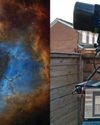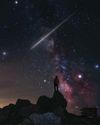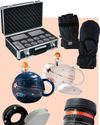
As September approaches, astronomers leave the long, hazy days and short, bright nights of summer behind and welcome the return of dark skies. The longer, darker nights allow us to view some of the most loved and prized night-sky objects that return each autumn.
And there's a lot to look forward to this season, whether you're using your naked eye, binoculars or a telescope. This guide will help you find some fascinating objects, either from your garden or from a dark-sky site away from light pollution, whether you're an absolute beginner or a more well-seasoned astronomer. Remember to wrap up warm and grab a red torch to follow this guide as you head out into the dark. Downloading a stargazing app will help you find your way around the targets we highlight too.
September
After midnight on 4 September, Jupiter will be shining close to a waning Moon low in the eastern sky. Just over a week later, on 12 September, a very thin waning crescent Moon and Venus will create a spectacular sight just before dawn. At 6:50am on 23 September, the autumn equinox occurs - the point at which the Sun illuminates the Northern and Southern Hemispheres equally, marking the start of autumn in the Northern Hemisphere. After sunset on 29 September, look to the east to see the last supermoon of the year rise above the horizon, when it will appear bigger and brighter than usual.
During September, comet 103P/Hartley could become a viable target to track for sky-watchers with binoculars and small telescopes.
Constellations of the month include Andromeda and Cassiopeia. They lie close to each other and are visible after 10pm towards the northeast. Use Cassiopeia, the distinctive W-shaped constellation, to star-hop to Andromeda. The brightest stars in Andromeda are Alpheratz (Alpha Andromedae), Mirach and Almach.
この記事は BBC Sky at Night Magazine の September 2023 版に掲載されています。
7 日間の Magzter GOLD 無料トライアルを開始して、何千もの厳選されたプレミアム ストーリー、9,000 以上の雑誌や新聞にアクセスしてください。
すでに購読者です ? サインイン
この記事は BBC Sky at Night Magazine の September 2023 版に掲載されています。
7 日間の Magzter GOLD 無料トライアルを開始して、何千もの厳選されたプレミアム ストーリー、9,000 以上の雑誌や新聞にアクセスしてください。
すでに購読者です? サインイン

Putting cosmic rays to work
These penetrating interstellar particles have applications from astronomy to archaeology

Set up your first imaging sequence
How to automate and coordinate your gear over multiple nights of imaging

The Universe without gravity
Life with no gravity might sound a fun idea, but as Govert Schilling explains, shutting off this pivotalforce would spell disaster for Earth and beyond

How to blend images taken with different camera setups
Combine data captured at varied focal lengths to create rich, deep images

INSIDE THE SKY AT NIGHT
Back in September 2021, The Sky at Night show spoke to Carly Howett about NASA's then upcoming Lucy mission. As the spacecraft now approaches its main targets - the Trojan asteroids - we check in with her to see how the mission is going

The science of SCI-FI
We love a good sci-fi film, but do they get the science right? Amy Arthur picks six of the big mistakes made in space films

Seeing in a new light
It's National Astronomy Week this month, so take a tip from Mark Westmoquette and let mindful stargazing change your perspective on your life and problems

What to do if you find a meteorite
Ever come across an unusual rock and wondered if it's a meteorite? Mark McIntyre explains how to tell if that stone really is a fragment from outer space

GEAR
Charlotte Daniels rounds up the latest astronomical accessories

Q&A WITH A STELLAR ECLIPSE SPECIALIST
Many stars are gravitationally locked inside multi-star systems, but a rare new triple-star system has set a new record for how cosy these clusters can get